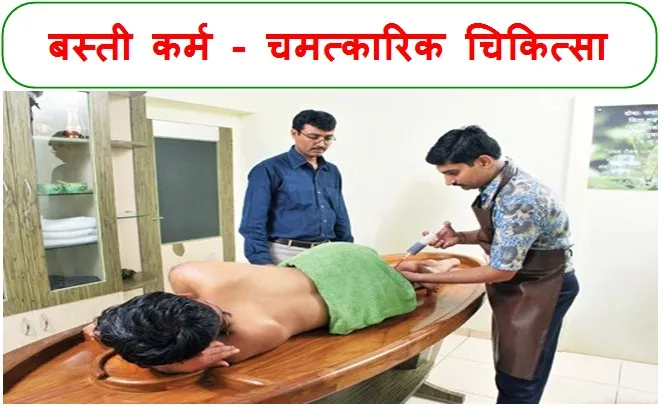
BASTI KARMA IN AYURVEDA
- November 24, 2022
- Posted by Dr. Vaidya Karanvir Singh
- 0 Comment(s)
Table of Contents
Understanding Basti Karma:
Human body comprises of three body elements (doshas) such as Vata, pitta and Kapha. Imbalnce of any of these dosha is the root cause of all the diseases in the body. Hence these has to in a balnced state of mind. Ayurved Acharyas has mentioned 5 karmas known as Panchkarmas for sodhana chikitsa (biocleansing) those are Vaman (therapeutic emesis) to balance kapha , Virechan (therapeutic purgation) to balance pitta , Basti (medicated emesis) to balance vata, nasya (nasal therapy) and raktamokhan to balance rakta (bloodletting).
Basti karma is administeration of herbal decoction or medicated oil through anal route or urethral route. Basti is often misconcepted with nomal enema that it is used to clear bowel and relieve constipation. According to Ayurveda classics Basti has therapeutic action on rejuvenation of all the body tissues, prevents various diseases, increasing longitivity and restores health. Basti is the best therapy to restore aggravated vata inside the body and restores its normal flow.
Acharya charak has mentioned Basti as Ardha Chikitsa that is half treatment for management of all diseases.
Benefits of Basti karma:
“बस्तिर्वयःस्थापयिता सुखायुर्बलाग्निमेधास्वरवर्णकृच्च|
सर्वार्थकारी शिशुवृद्धयूनां निरत्ययः सर्वगदापहश्च||
विट्श्लेष्मपित्तानिलमूत्रकर्षी दार्ढ्यावहः शुक्रबलप्रदश्च|
विश्वक्स्थितं दोषचयं निरस्य सर्वान् विकारान् शमयेन्निरूहः||”
(charak siddhi sthan)
- Basti prevents aging
- Promotes happiness, longevity, strength, power of digestion, intelligence, voice and complexion.
- Accomplishes all objects
- Harmless to children , old and youth
- Evacuates feces, Kapha, pitta, vata and urine in sequence
- Promotes sturdiness of the body
- Enriches semen and promotes strength
- It cures all the disease causing doshas (toxins) accumulated inside the body
Types of Basti Chikista:
There are mainly three types of bastis :
- Niruha Basti (asthapan Basti ): It is prepared with the decoction of herbs with other ingredients like honey, salt, lipid. Niruh word itself signifies to eliminate morbid doshas.
- Anuvasan Basti (Sneha Basti): This basti is prepared with medicated ghee, oil, lipids. Anuvasan word signifies “to stay” that means administered Basti stays inside body for longer duration without causing any harm.
- Uttar Basti : Administration of Ghee, medicated oil or decoction into female uterus through vaginal route or in males through urethral route. It is
Beneficial for the strengthen reproductive system.
Mode of Action of Basti Chikitsa:
“बलदोषकालरोगप्रकृतीः प्रविभज्य योजिताः सम्यक्
स्वैः स्वैरौषधवर्गैः स्वान् स्वान् रोगान्नियच्छन्ति||
कर्मान्यद्बस्तिसमं न विद्यते शीघ्रसुखविशोधित्वात्|
आश्वपतर्पणतर्पणयोगाच्च निरत्ययत्वाच्च||”
Ayurveda mentioned Vata as the most significant dosha inside the body whose tendency is to flow but when vata dosha gets imbalanced in the body it causes major health issues. Imabalnce of vata dosha interferes with the functioning of the body. Basti helps in the removal of toxins and waste materials from the system. Basti attract the toxins from whole body into large intestine (pakvashya) which is the focal point of vata and cleanses the area. It helps to eliminate morbid toxins and provide nourishment to the body. The drugs and herbs in the Basti is getting absorbed and have it therapeutic action on various conditions like Rheumatoid arthritis, autoimmune disorders, PCOD, Sensory dysfunction, hemiplegia, atrophy of nerves and vessel etc.
Basti according to Doshas:
- Vata Dosha: Madhur and amla rasa Pradhan herbs like Dashmool, Ashwagandha etc
- Pitta Dosha: Tikta And Madhur rasa Pradhan Herbs like neem, vasa, chandan, Manjistha etc.
- Kapha Dosha: Kashaya rasa pradhan herbs like Trikatu, pippali, punarnava etc.
Administeration of Basti:
- Best time to administer Basti is early morning or evening specially in that time of the days when Vata dosha at its peak.
- The Basti is given empty stomach, there is gap of at least 3-4 hours after meals but Anuvasan Basti Or Oil enema can be given emty Stomach
- The ares where Basti is given should be clean, warm comfortable and toilet is nearby to that room
- The material used in the basti like Basti Netra, enema bag, measuring cups, towels etc should be sterilized.
- Basti is given in Left lateral position
- Basti is having maximum benefits if retained for longer time in the intestine (for about 45 min)
Indications of Basti Chikitsa:
- Paralysis of one or whole limb (ekaang roga or sarvaang roga)
- Retention of vata dosha, feces, urine, semen
- Decreasing strength (Bala khshaya)
- Parasitic manifestation of intestine (krimikostha)
- Shool (colic pain)
- Psin, atrophy and stiffness of whole body
- Diarrhea without association of Ama
- Fistula in ano
- Tearing pain in joints due to RA, Gout, Arthritis
- Skin disorders like psoriasis, eczema
- Strengthening reproductive system and improves fertility
- Anuvasan Basti is helpful in combating dryness in the body, improves digestion, and person suffering from vata roga
Contraindication of Basti Chikitsa:
- Indigestion ( Ajeerna)
- Weak digestive power
- Person who is excessively weak and emaciated
- Person who is hungry and thirsty
- Person who has feeling of fear and anger
- Dyspnea
- Cold and cough
- Diseases like ascites, intestinal perforation, intestinal obstruction, Diabetes etc.
- Anuvasan Basti is contraindicated in Acute fever, anorexia, jaundice, anemia, intestinal parasites etc

Dr. Vaidya Karanvir Singh is the younger Vaidya in Chandigarh Ayurved & Panchakarma Centre. He is the fourth generation in his family who is practicing as a general consultant in Ayurved & Panchakarma treatment at Chandigarh. In his practice, he had treated more than 1 Lakh Plus patients worldwide.

